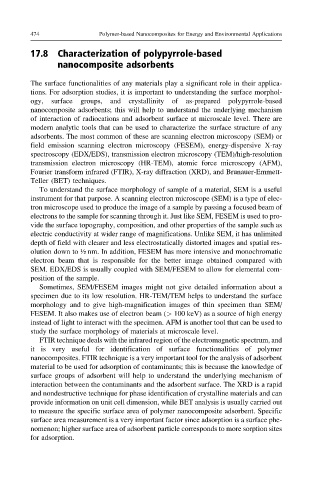Page 521 - Polymer-based Nanocomposites for Energy and Environmental Applications
P. 521
474 Polymer-based Nanocomposites for Energy and Environmental Applications
17.8 Characterization of polypyrrole-based
nanocomposite adsorbents
The surface functionalities of any materials play a significant role in their applica-
tions. For adsorption studies, it is important to understanding the surface morphol-
ogy, surface groups, and crystallinity of as-prepared polypyrrole-based
nanocomposite adsorbents; this will help to understand the underlying mechanism
of interaction of radiocations and adsorbent surface at microscale level. There are
modern analytic tools that can be used to characterize the surface structure of any
adsorbents. The most common of these are scanning electron microscopy (SEM) or
field emission scanning electron microscopy (FESEM), energy-dispersive X-ray
spectroscopy (EDX/EDS), transmission electron microscopy (TEM)/high-resolution
transmission electron microscopy (HR-TEM), atomic force microscopy (AFM),
Fourier transform infrared (FTIR), X-ray diffraction (XRD), and Brunauer-Emmett-
Teller (BET) techniques.
To understand the surface morphology of sample of a material, SEM is a useful
instrument for that purpose. A scanning electron microscope (SEM) is a type of elec-
tron microscope used to produce the image of a sample by passing a focused beam of
electrons to the sample for scanning through it. Just like SEM, FESEM is used to pro-
vide the surface topography, composition, and other properties of the sample such as
electric conductivity at wider range of magnifications. Unlike SEM, it has unlimited
depth of field with clearer and less electrostatically distorted images and spatial res-
olution down to ½ nm. In addition, FESEM has more intensive and monochromatic
electron beam that is responsible for the better image obtained compared with
SEM. EDX/EDS is usually coupled with SEM/FESEM to allow for elemental com-
position of the sample.
Sometimes, SEM/FESEM images might not give detailed information about a
specimen due to its low resolution. HR-TEM/TEM helps to understand the surface
morphology and to give high-magnification images of thin specimen than SEM/
FESEM. It also makes use of electron beam (> 100 keV) as a source of high energy
instead of light to interact with the specimen. AFM is another tool that can be used to
study the surface morphology of materials at microscale level.
FTIR technique deals with the infrared region of the electromagnetic spectrum, and
it is very useful for identification of surface functionalities of polymer
nanocomposites. FTIR technique is a very important tool for the analysis of adsorbent
material to be used for adsorption of contaminants; this is because the knowledge of
surface groups of adsorbent will help to understand the underlying mechanism of
interaction between the contaminants and the adsorbent surface. The XRD is a rapid
and nondestructive technique for phase identification of crystalline materials and can
provide information on unit cell dimension, while BET analysis is usually carried out
to measure the specific surface area of polymer nanocomposite adsorbent. Specific
surface area measurement is a very important factor since adsorption is a surface phe-
nomenon; higher surface area of adsorbent particle corresponds to more sorption sites
for adsorption.

